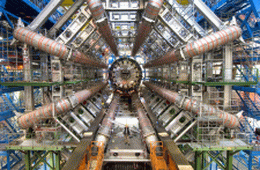Grid computing for the masses

(PhysOrg.com) -- Having helped scientists study the building blocks of the universe, peer inside the human body in miniscule detail and monitor climate change, grid computing could soon be put to more mundane uses by your home or office computer.
A team of European researchers has developed middleware designed to allow any computer running any operating system to simply, efficiently and cost-effectively access the distributed computers that make up the grid. Their work promises to trigger a kind of popular revolution in which everyone will be granted access to the powerful resource-sharing technology that, until now, has largely been the preserve of academia.
“Grid computing, which allows users to access the computing resources of many different machines distributed around the world, has been invaluable to science. However, much of the business world and the general public have had few ways to use it due to the complexity of installing and configuring grid software, accessing grid networks, obtaining permissions to use resources... etc,” explains Farid Ould-Saada, a physicist at the University of Oslo, Norway.
Working in the EU-funded KnowARC project, Ould-Saada is leading a team of researchers in an effort to expand accessibility to grid resources. Their ultimate goal is to make computing power on the grid as easily accessible to everyone as information is on the internet.
“Getting access to the grid should be as simple as installing a new browser to get on the internet… only then will the survival and expansion of the grid be assured,” the KnowARC director says.
In an effort to achieve that goal, the KnowARC researchers set about improving existing Advanced Resource Connector (ARC) middleware - software designed to provide interoperability between computing systems, architectures and platforms. Originally developed by several Nordic research institutes in the Nordugrid collaboration, which is currently chaired by Ould-Saada, the next-generation ARC middleware is now being used across Europe to set up grid networks.
The software was recently selected by the European Grid Initiative Design Study (EGI_DS) as one of three key middleware solutions for a stable and sustainable European super-grid infrastructure. And, thanks to work carried out in the KnowARC project, it will soon be provided as a standard installation with the popular Debian and Fedora distributions of open source operating system Linux, giving anyone easy access to grid resources.
“Providing ARC through Linux distributions was one of the goals of the project… and we also wanted to ensure deployment on proprietary operating systems such as MS Windows and Mac OS. This has always been something of a challenge because in data-driven scientific computing Linux is the platform of choice, but we’ve reached the point of full platform independence,” Ould-Saada says.
Solving the interoperability challenge
Because of the distributed and diverse nature of the resources that make up the grid, interoperability is essential. A single user, for example, will often need to use resources from multiple computers with different processing speeds, running different operating systems and connected in different ways to the network and even to separate grids. The ARC system constitutes that necessary bridge, thanks in part to the KnowARC team’s use of and contributions to standards to build their middleware, including several proposed by the international Open Grid Forum (OGF).
The complex processes that provide interoperability and share grid resources are largely automatic and hidden from the user, bringing the time it takes to install, configure and use the ARC system down to a couple of hours instead of days or even weeks.
“Typically, in an academic environment, accessing the grid has been extremely complex. It involves training people to use it, obtaining permissions to use resources and installing and configuring the necessary software. With the ARC middleware much of this complexity is eliminated,” the project manager says.
Significantly, simplicity is not a handicap to performance. Of the three middleware solutions selected by the European Grid Initiative (UNICORE and gLite are the other two), Ould-Saada is confident that ARC has the most potential for wide deployment in new domains due to its ease of installation and use. He points to Nordugrid’s valuable contribution to the processing of the enormous amounts of data produced by the Large Hadron Collider at CERN in Switzerland.
“We were supposed to contribute 5 percent of the total computational resources, but in reality we have been contributing 10 percent and in some instances as much as 30 percent,” he notes.
As a result of the KnowARC team’s work and their promotional activities, the ARC middleware is also being used as the basis for grid computing solutions in a variety of fields, including medicine, bioinformatics and geographical data.
“At Geneva University Hospital, ARC helps researchers intelligently access their medical image database, which grows by more than 100,000 images per day. Also in Switzerland we work with the Swiss Multi Science Computing Grid where ARC is helping researchers build models of Alpine terrain in order to monitor changes and predict the risk of avalanches,” Ould-Saada says.
Looking ahead, the KnowARC director expects the grid and the ARC middleware to continue to evolve. He points, for example, to the emerging integration of grid computing with cloud computing in which storage as well as computational resources are distributed.
“In a matter of years, I hope to see resources and storage being as easy to access remotely as information is on the internet today,” he says.
More information: KnowARC project: www.knowarc.eu/
Provided by ICT Results















